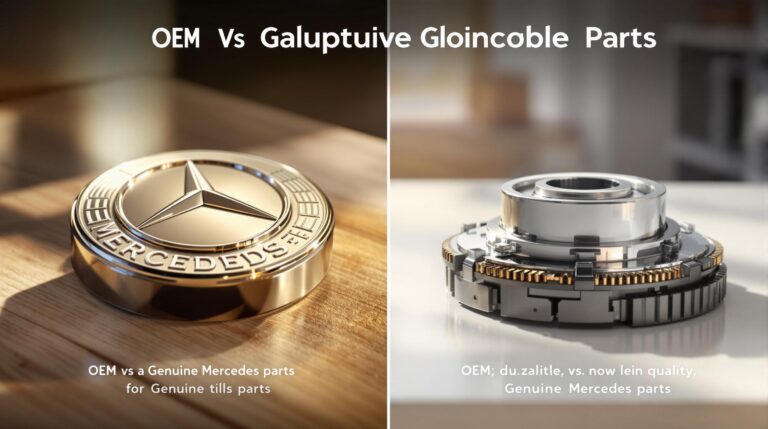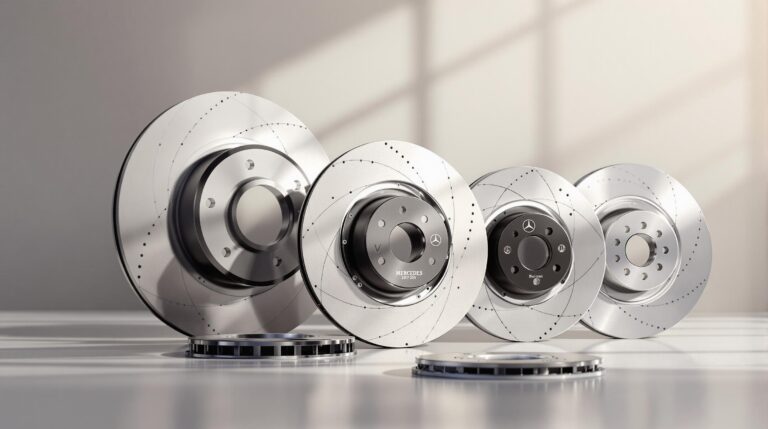Mercedes Air Filter Guide: When and How to Replace
Keeping your Mercedes-Benz air filter clean is crucial for engine performance, fuel efficiency, and reducing emissions. Here’s what you need to know:
- When to Replace: Every 10,000 to 45,000 miles, depending on your model and driving conditions (e.g., dusty or polluted areas require more frequent changes).
- Signs of a Dirty Filter: Increased fuel consumption, reduced engine performance, unusual noises, or a dashboard warning light.
- Types of Filters:
- Genuine Mercedes: Best fit, $40-80
- OEM (Mann, Mahle): Reliable, $25-45
- Performance (K&N): Reusable, $50-100
- DIY Tools Needed: Screwdrivers, a microfiber cloth, and gloves. For some models, specific tools like a Torx bit may be required.
Quick Overview of Replacement Steps:
- Locate the filter box (near the engine compartment).
- Remove the old filter and clean the housing.
- Insert the new filter and ensure a proper seal.
- Close the housing and inspect for issues.
Replacing your air filter regularly improves engine performance, saves fuel costs (up to 20%), and protects vital engine components. Always consult your vehicle manual for specific guidelines.
Mercedes-Benz E350 Engine Air Filter Replacement DIY

When to Replace Your Mercedes Air Filter
Spotting the signs of a failing air filter early can help you keep your Mercedes running smoothly and prevent unnecessary engine strain.
Increased Fuel Consumption and Reduced Performance
A dirty air filter blocks airflow, making your engine work harder than it should. This can lead to a noticeable increase in fuel usage – anywhere from 5% to 20% – and cause slower acceleration, reduced overall performance, and difficulty maintaining highway speeds .
Unusual Engine Noises
If your air filter is clogged, you might hear odd sounds like coughing, sputtering, or rough idling, particularly when accelerating .
Dashboard Warning Lights
In Mercedes vehicles, a severely clogged air filter can trigger the Engine Management Light (EML), signaling that it’s time for a closer look .
Visual Check of the Air Filter
Regularly inspecting your air filter can help you catch problems before they escalate. Here’s a quick guide:
| Filter Condition | What to Do |
|---|---|
| Light dust present | Keep an eye on it |
| Heavy dirt buildup | Plan to replace soon |
| Visible debris or damage | Replace immediately |
| Dark discoloration | Replace the filter |
Keeping an eye out for these signs is key, but don’t forget to follow the replacement schedule recommended for your specific Mercedes model.
Filter Change Schedule
Mercedes-Benz Model Guidelines
Mercedes-Benz vehicles have varying air filter replacement intervals depending on the model and engine design. For example, the Mercedes-Benz C350 typically requires a new filter every 10,000 miles . Other models might go anywhere from 15,000 to 45,000 miles before needing a replacement .
| Model Type | Recommended Interval | Notes |
|---|---|---|
| Standard/High-Performance | 10,000-45,000 miles | AMG models require shorter intervals |
| R 320 CDI | 10,000-15,000 miles | Features a more complex filtration system |
These intervals serve as a general guide, but external factors can impact how often the filter should be replaced.
Factors Influencing Replacement Schedule
Certain environmental conditions can cause filters to wear out faster, including:
- Hot, dusty climates
- High-pollution urban areas
- Rural locations with excessive debris
Your vehicle’s manual is the best source for specific maintenance intervals, dashboard warning explanations, and filter details. However, if you frequently drive in challenging conditions, you’ll need to adjust your replacement schedule accordingly.
To keep your air filter in top shape:
- Stick to the base interval listed for your model.
- Consider environmental factors like pollution or debris.
- Check your filter regularly for signs of wear.
- Replace it more often if necessary, especially in harsh conditions.
Driving in areas with high dust, pollution, or heat can speed up filter wear, so plan for replacements more frequently than the standard intervals suggest.
sbb-itb-395e243
Tools and Parts for Filter Change
Tools You’ll Need
Changing a Mercedes air filter doesn’t require a lot of tools, which makes it a great project for DIYers. Here’s what you’ll need:
- Basic wrenches and screwdrivers
- A clean microfiber cloth to wipe away dirt
- Work gloves for safety and grip
- Optional: A flashlight to help with visibility in tight spaces
For some models, like the E-Class Coupe (C207), you might need specific tools. Check your vehicle’s manual for details.
Choosing the Right Filter
Once you have the tools, the next step is picking the right filter. Here’s a quick comparison of the most common options:
| Filter Type | Features and Cost |
|---|---|
| Genuine Mercedes | Best fit and quality, but pricey ($40-80) |
| OEM (Mann, Mahle) | Reliable, close to original quality ($25-45) |
| Performance (K&N) | Reusable, high airflow, but needs upkeep ($50-100) |
Always use a filter designed for your specific model to ensure proper performance and prevent potential damage .
Where to Buy
You can find Mercedes air filters at several places:
- Official Mercedes-Benz dealerships for guaranteed compatibility
- Online retailers like CarParts.com.au, which offer a variety of options and shipping convenience
- Local auto parts stores for quick access
Make sure to double-check that the filter matches your car’s model and production year before purchasing. Once you have the right tools and filter, you’re all set to tackle the replacement.
Filter Replacement Steps
Locate the Filter Box
In most Mercedes models, the air filter box is positioned near the front of the engine compartment, enclosed in a plastic or metal casing. For C-Class models, it’s typically right behind the engine cover. Make sure the engine is completely cool and turned off before starting.
Remove the Old Filter
Detach the air intake hoses connected to the filter housing. Use a T20 or T25 Torx bit to unscrew or unclip the housing cover, then carefully set the screws or clips aside for reassembly.
Clean the Filter Housing
Use a microfiber cloth to wipe down the inside of the housing and the sealing surfaces. Make sure no dirt or debris is left, especially in the air intake tube.
Insert the New Filter
Position the new filter properly, ensuring the rubber seal fits tightly to prevent contaminants from entering. Using a reliable, high-quality filter helps protect your engine and maintain performance.
Close and Inspect
Here’s how to address some common issues that might come up:
| Issue | Fix |
|---|---|
| Fluctuating idle RPM | Check and secure all duct connections |
| Engine warning light | Ensure the filter is installed correctly and the housing is sealed |
| Odd engine noises | Double-check that all clips and screws are tightened properly |
Before closing the hood, ensure everything is securely in place. If you’re replacing the filter for the first time, consider consulting a Mercedes specialist for guidance specific to your model. With the new filter installed, your engine is ready to run smoothly, emphasizing the value of regular upkeep.
Why Regular Filter Changes Matter
Improved Engine Performance
Did you know a clean air filter can prevent up to a 10% drop in performance for your Mercedes-Benz? According to the American Automobile Association (AAA) , keeping your filter clean ensures smoother acceleration and more responsive power.
Lower Fuel Expenses
Replacing a dirty air filter can save you money at the pump. The U.S. Department of Energy states that a clean filter can boost gas mileage by up to 20% . For example, if you spend $200 a month on fuel, you could save around $40 just by maintaining a clean air filter.
Protects Engine Components
A clean air filter shields critical engine parts from harmful debris, extending their lifespan. Here’s how it helps:
| Component | Benefit of a Clean Filter |
|---|---|
| Valves | Blocks abrasive particles that cause wear |
| Pistons | Prevents debris from scratching cylinder walls |
| Cylinder Walls | Ensures proper compression by maintaining smooth surfaces |
| Engine Oil | Reduces contamination, slowing down oil degradation |
Reduces Emissions
Keeping your air filter clean also helps the environment. Research from the Car Care Council shows that a clean filter can cut emissions by up to 15% . It also reduces fuel consumption by 12%, aligning with Mercedes-Benz’s maintenance standards.
"Regular air filter changes can lead to significant improvements in fuel efficiency and engine performance. Using genuine or high-quality OEM filters is crucial to ensure optimal engine performance and longevity."
Quick Review
Replacing the air filter in your Mercedes-Benz is a straightforward but important task. It should be done every 10,000 to 15,000 miles, depending on your model . Signs that it’s time for a new filter include higher fuel consumption, reduced engine performance, or unusual engine noises.
You’ll need a few basic tools for the job: a Torx bit (T20 or T25), a ratchet wrench, and a microfiber towel .
Here’s an overview of the process:
| Step | Action |
|---|---|
| Preparation | Open the bonnet and remove the engine cover. |
| Access | Locate the filter housing and open it. |
| Replacement | Take out the old filter and clean the housing. |
| Installation | Align the new filter correctly in the housing. |
| Completion | Close and secure the filter housing. |
Using high-quality OEM or genuine Mercedes-Benz filters is crucial. These ensure proper fit and prevent air leaks, which could otherwise affect engine performance .
Always refer to your vehicle’s manual for specific instructions and maintenance schedules. Regularly replacing the air filter helps keep your Mercedes-Benz running efficiently for the long haul.







